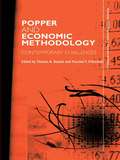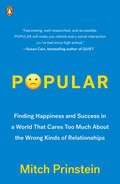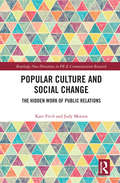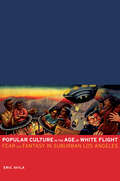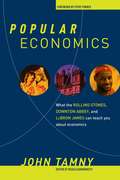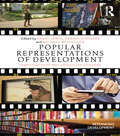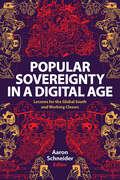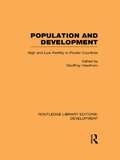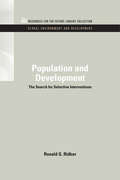- Table View
- List View
The Pope's Children
by David McwilliamsNamed for the ironic coincidence of the Irish baby boom of the 1970s, which peaked nine months to the day after Pope John Paul II's historic visit to Dublin, The Pope's Children is both a celebration and bitingly funny portrait of the first generation of the Celtic Tiger-the beneficiaries of the economic miracle that propelled Ireland from centuries of deprivation into a nation that now enjoys one of the highest living standards in the world.
Popper and Economic Methodology: Contemporary Challenges (Routledge Inem Advances In Economic Methodology #9)
by Thomas A. Boylan Paschal F. O’GormanThis new book, under the impressive editorship of Thomas Boylan and Paschal O'Gorman, explores a number of major themes central to the work of Karl Popper.The tensions that have resulted from Popperian thought are well documented. How can mainstream orthodox economics be falsifiable while privileging its core of rationality as unquestionable?
Popper, Hayek and the Open Society (Routledge Frontiers of Political Economy #Vol. 112)
by Calvin HayesThis is the first book to compare Karl Popper and Friedrich Hayek systematically, and critically assess their contribution to the political philosophy of the Open Society. Hayes compares and contrasts their views on three key areas relevant to their political philosophy; first their views on scientific method, their views on philosophy of social science and then their moral philosophy including their meta-ethical views. The author focuses on their contributions to social science methodology, their ethical views about negative utilitarianism and negative rights, and their contrasting views on Utopianism. He finishes by arguing that their versions of liberal political philosophy are both immune to Alastair MacIntyre's critique of liberal individualism and also meet his challenge to the Enlightenment project. Hayes' position is generally controversial in that he defends Popper and Hayek in areas where they are almost universally criticized, namely Hayek's notion of the meaninglessness of social justice and Popper's claim that there is no need for induction in either scientific reasoning or common sense reasoning. One main finding in this book concerns the two major problems that bedevil modern philosophy: induction and the is-ought problem. The author proposes an original solution to the is-ought problem as well to the infinite regress problem.
Poppy: A Modern Village for Childcare
by Jeff Huizinga Thomas R. EisenmannIn 2017, management at Poppy, which matched families that required occasional childcare with thoroughly vetted caregivers, was formulating plans for the Seattle-based seed-stage startup's next phase of expansion. One option was to grow using the same business model through geographic expansion to cities beyond Seattle. Another option was to deepen penetration within Seattle by recruiting caregivers with less experience and by broadening the range of services caregivers could provide, e.g., driving children to appointments.
Poppy: A Modern Village for Childcare
by Jeff Huizinga Thomas R. EisenmannIn 2017, management at Poppy, which matched families that required occasional childcare with thoroughly vetted caregivers, was formulating plans for the Seattle-based seed-stage startup's next phase of expansion. One option was to grow using the same business model through geographic expansion to cities beyond Seattle. Another option was to deepen penetration within Seattle by recruiting caregivers with less experience and by broadening the range of services caregivers could provide, e.g., driving children to appointments.
Popular: Finding Happiness and Success in a World That Cares Too Much About the Wrong Kinds of Relationships
by Mitch PrinsteinA leading psychologist examines how our popularity affects our success, our relationships, and our happiness—and why we don’t always want to be the most popularNo matter how old you are, there’s a good chance that the word “popular” immediately transports you back to your teenage years. Most of us can easily recall the adolescent social cliques, the high school pecking order, and which of our peers stood out as the most or the least popular teens we knew. Even as adults we all still remember exactly where we stood in the high school social hierarchy, and the powerful emotions associated with our status persist decades later. This may be for good reason. Popular examines why popularity plays such a key role in our development and, ultimately, how it still influences our happiness and success today. In many ways—some even beyond our conscious awareness—those old dynamics of our youth continue to play out in every business meeting, every social gathering, in our personal relationships, and even how we raise our children. Our popularity even affects our DNA, our health, and our mortality in fascinating ways we never previously realized. More than childhood intelligence, family background, or prior psychological issues, research indicates that it’s how popular we were in our early years that predicts how successful and how happy we grow up to be. But it’s not always the conventionally popular people who fare the best, for the simple reason that there is more than one type of popularity—and many of us still long for the wrong one. As children, we strive to be likable, which can offer real benefits not only on the playground but throughout our lives. In adolescence, though, a new form of popularity emerges, and we suddenly begin to care about status, power, influence, and notoriety—research indicates that this type of popularity hurts us more than we realize. Realistically, we can’t ignore our natural human social impulses to be included and well-regarded by others, but we can learn how to manage those impulses in beneficial and gratifying ways. Popular relies on the latest research in psychology and neuroscience to help us make the wisest choices for ourselves and for our children, so we may all pursue more meaningful, satisfying, and rewarding relationships.
Popular Advertising Cuts of the Twenties and Thirties (Dover Pictorial Archive)
by Leslie CabargaCommercial artists and others looking for distinctive illustrations to enhance their various projects will be impressed by the attractive graphics in this comprehensive collection. Selected from rare magazines, newspapers, catalogs, and other printed materials from the 1920s and '30s, over 900 cuts cover a wide range of categories: men, women, sports, animals, food and refreshments, communications, entertainment, holidays, trades and services, and much more.Here are lively illustrations of old-time radio announcers, pianists and other musicians, a barbershop quartet, a ukulele player, ballroom dancers, orators and town criers, candlelit Christmas trees, Santa Claus, horses, roosters, storks, hairstyles for women, and many other images.Sure to bring period charm to any graphic assignment, these sharply detailed, eye-catching illustrations will also intrigue nostalgia buffs with their fascinating commentary on lifestyles of the early 20th century.
Popular Capitalism (Routledge Revivals)
by Sir John RedwoodSir John Redwood has been at the centre of the movement to speed up the growth in wealth and income around the world through the rediscovery of private enterprise. In the United Kingdom, he has argued and written for privatisation, deregulation, and wider ownership—policies he helped to implement as a government adviser and as Head of the Prime Minister’s Policy Unit. Elsewhere, in countries as diverse as Jamaica, New Zealand, Singapore, and France, he has advised governments on industrial policies and privatisation and has supervised major share issues.In Popular Capitalism (first published in 1988 and now with a new preface by the author) Redwood draws on his wide-ranging experience to illustrate major economic changes happening around the world. He shows that privatisation, deregulation, venture capital, wider ownership, debt repayment and the growth of new markets are all scenes in a larger drama: the story of how the world is responding to the failure of public sector led growth and to the overburdening of debt that has so damaged countries, companies, and even banks. Popular capitalism is a worldwide phenomenon, embracing Latin America, Gorbachev’s reforms, China’s own style of local capitalism, and the large government privatisation programmes of the developed world.
Popular Culture and Social Change: The Hidden Work of Public Relations (Routledge New Directions In Public Relations & Communication Ser.)
by Kate Fitch Judy MotionPopular Culture and Social Change: The Hidden Work of Public Relations argues the complicated and contradictory relationship between public relations, popular culture and social change is a neglected theoretical project. Its diverse chapters identify ways in which public relations influences the production of popular culture and how alternative, often community-driven conceptualisations of public relations work can be harnessed for social change and in pursuit of social justice. This book opens up critical scholarship on public relations in that it moves beyond corporate understandings and perspectives to explore alternative and eclectic communicative cultures, in part to consider a more optimistic conceptualisation of public relations as a resource for progressive social change. Fitch and Motion began with an interest in identifying the ways in which public relations both draws on and influences the production of popular culture by creating, promoting and amplifying particular narratives and images. The chapters in this book consider how public relations creates popular cultures that are deeply compromised and commercialised, but at the same time can be harnessed to advocate for social change in supporting, reproducing, challenging or resisting the status quo. Drawing on critical and sociocultural perspectives, this book is an important resource for researchers, educators and students exploring public relations theory, strategic communication and promotional culture. It investigates the entanglement of public relations, popular culture and social change in different social, cultural and political contexts – from fashion and fortune telling to race activism and aesthetic labour – in order to better understand the (often subterranean) societal influence of public relations activity.
Popular Culture in the Age of White Flight: Fear and Fantasy in Suburban Los Angeles (American Crossroads #13)
by Eric AvilaLos Angeles pulsed with economic vitality and demographic growth in the decades following World War II. This vividly detailed cultural history of L.A. from 1940 to 1970 traces the rise of a new suburban consciousness adopted by a generation of migrants who abandoned older American cities for Southern California's booming urban region. Eric Avila explores expressions of this new "white identity" in popular culture with provocative discussions of Hollywood and film noir, Dodger Stadium, Disneyland, and L.A.'s renowned freeways. These institutions not only mirrored this new culture of suburban whiteness and helped shape it, but also, as Avila argues, reveal the profound relationship between the increasingly fragmented urban landscape of Los Angeles and the rise of a new political outlook that rejected the tenets of New Deal liberalism and anticipated the emergence of the New Right. Avila examines disparate manifestations of popular culture in architecture, art, music, and more to illustrate the unfolding urban dynamics of postwar Los Angeles. He also synthesizes important currents of new research in urban history, cultural studies, and critical race theory, weaving a textured narrative about the interplay of space, cultural representation, and identity amid the westward shift of capital and culture in postwar America.
Popular Economics: What the Rolling Stones, Downton Abbey, and LeBron James Can Teach You about Economics
by John Tamny Foreword by Steve ForbesJohn Tamny uses entertaining stories from sports, movies, popular culture, and famous businesses to explain the basic principles of economics. His Dollars and Sense is an everyman’s guide to how money really works--a lesson politicians try (and fail) to grasp every day.
Popular Management Books: How they are made and what they mean for organisations
by Staffan FurustenThe growing interest in management knowledge has generated an enormous literature and brought great success for a number of management gurus. This book is a timely and radical critique of the quick-fix solutions offered by popular management books. Features include:*Detailed criticism of the ideological hegemony of North American managerial discour
Popular Manufacturing Myths: Eliminating Widely Held Beliefs That Reduce Competitiveness
by Douglas B. RelyeaAddressing the beliefs and attitudes that can be detrimental to your organization’s competitiveness, Popular Manufacturing Myths: Eliminating Widely Held Beliefs That Reduce Competitiveness offers time-tested insight into the most common myths encountered in manufacturing environments. It classifies these myths into management myths, shop floor myths, and if appropriate, shared management and shop floor myths.Explaining the reasons why these deeply ingrained beliefs exist, the book outlines remedies that can help to quickly dispel them within your organization. It presents case studies that examine these myths and includes numerous real-world examples that outline simple, yet effective, solutions. Some of the myths dispelled in this book include: Increasing line speed always decreases quality and creates more scrap Reducing the cost of raw materials will decrease the cost of manufacturing Increased inspection will boost quality If it is successful in R&D, it will be successful in production Process problems can only be solved by changing one process parameter at a time Covering the basics of data collection tools, techniques, and analysis, the text offers simple methods to structure your data to assist in communicating clear and logical conclusions across the organization. The author keeps the arithmetic and statistics to a minimum, so readers only require a basic understanding of averaging and normal variation. However, for those who wish to understand a little bit more about a particular concept, technique, tool, or procedure, the book includes an addendum chapter with more detailed explanations and sample calculations.
Popular Music in a Digital Music Economy: Problems and Practices for an Emerging Service Industry (Routledge Research in Music)
by Tim J. AndersonIn the late 1990s, the MP3 became the de facto standard for digital audio files and the networked computer began to claim a significant place in the lives of more and more listeners. The dovetailing of these two circumstances is the basis of a new mode of musical production and distribution where new practices emerge. This book is not a definitive statement about what the new music industry is. Rather, it is devoted to what this new industry is becoming by examining these practices as experiments, dedicated to negotiating what is replacing an "object based" industry oriented around the production and exchange of physical recordings. In this new economy, constant attention is paid to the production and licensing of intellectual property and the rise of the "social musician" who has been encouraged to become more entrepreneurial. Finally, every element of the industry now must consider a new type of audience, the "end user", and their productive and distributive capacities around which services and musicians must orient their practices and investments.
Popular Music Industries and the State: Policy Notes (Routledge Studies in Popular Music)
by Martin Cloonan Shane Homan Jennifer CattermoleThis volume studies the relationships between government and the popular music industries, comparing three Anglophone nations: Scotland, New Zealand and Australia. At a time when issues of globalization and locality are seldom out of the news, musicians, fans, governments, and industries are forced to reconsider older certainties about popular music activity and their roles in production and consumption circuits. The decline of multinational recording companies, and the accompanying rise of promotion firms such as Live Nation, exemplifies global shifts in infrastructure, profits and power. Popular music provides a focus for many of these topics—and popular music policy a lens through which to view them. The book has four central themes: the (changing) role of states and industries in popular music activity; assessment of the central challenges facing smaller nations competing within larger, global music-media markets; comparative analysis of music policies and debates between nations (and also between organizations and popular music sectors); analysis of where and why the state intervenes in popular music activity; and how (and whether) music fits within the ‘turn to culture’ in policy-making over the last twenty years. Where appropriate, brief nation-specific case studies are highlighted as a means of illuminating broader global debates.
Popular Representations of Development: Insights from Novels, Films, Television and Social Media (Rethinking Development)
by David Lewis Michael Woolcock Dennis RodgersAlthough the academic study of development is well established, as is also its policy implementation, less considered are the broader, more popular understandings of development that often shape agendas and priorities, particularly in representative democracies. Through its accessible and provocative chapters, Popular Representations of Development introduces the idea that while the issue of ‘development’ – defined broadly as problems of poverty and social deprivation, and the various agencies and processes seeking to address these – is normally one that is discussed by social scientists and policy makers, it also has a wider ‘popular’ dimension. Development is something that can be understood through studying literature, films, and other non-conventional forms of representation. It is also a public issue, one that has historically been associated with musical movements such as Live Aid and increasingly features in newer media such as blogs and social networking. The book connects the effort to build a more holistic understanding of development issues with an exploration of the diverse public sphere in which popular engagement with development takes place. This book gives students of development studies, media studies and geography as well as students in the humanities engaging with global development issues a variety of perspectives from different disciplines to open up this new field for discussion.
Popular Sovereignty in a Digital Age: Lessons for the Global South and Working Classes
by Aaron SchneiderIn the evolution of global capitalism and geopolitics, digitalization presents a new and yet unresolved chapter. In the lead up to digitalization, neoliberalism weakened the welfare states of the Global North and the developmental states of the Global South where they existed. Neoliberalism also disorganized working classes, as Left parties and labor organization declined across the globe. Into this deregulated and unchecked context, digitalization proceeded, and technology companies inserted themselves into multiple sectors, making use of first mover advantage and monopolistic practices to drive out smaller and less advanced firms. We can now characterize a landscape in which states have been weakened, working classes disorganized, and rival firms greatly handicapped, allowing big tech to operate as all-powerful quasi-monopolies. They enjoy unprecedented concentration of wealth, power, and advantage. Worryingly, deregulated technology now penetrates many areas of life with surveillance and control, setting us on a path towards anti-democratic, neo-imperial, and exclusionary futures. Aaron Schneider offers a popular and sovereign alternative, with particular focus on labor and the Global South.
Popular Support for an Undemocratic Regime
by Neil Munro Richard Rose William MishlerTo survive, all forms of government require popular support, whether voluntary or involuntary. Following the collapse of the Soviet system, Russia's rulers took steps toward democracy, yet under Vladimir Putin Russia has become increasingly undemocratic. This book uses a unique source of evidence, eighteen surveys of Russian public opinion from the first month of the new regime in 1992 up to 2009, to track the changing views of Russians. Clearly presented and sophisticated figures and tables show how political support has increased because of a sense of resignation that is even stronger than the unstable benefits of exporting oil and gas. Whilst comparative analyses of surveys on other continents show that Russia's elite is not alone in being able to mobilize popular support for an undemocratic regime, Russia provides an outstanding caution that popular support can grow when governors reject democracy and create an undemocratic regime.
The Popularity of Basic Income: Evidence from the Polls (Exploring the Basic Income Guarantee)
by Tijs LaenenThis book provides a state-of-the-art overview of the popularity of basic income among the general public. Using data from a wide array of public opinion polls conducted in different countries and years, the book first charts popular support for the ideal-typical version of basic income, broadly defined as a "periodic cash payment unconditionally delivered to all on an individual basis, without means-test or work requirement”. On top of that, the book maps popular support for the many other, differently designed varieties of basic income that are part of real-world proposals, pilots, and experiments – including, for example, a participation income, a negative income tax, and a stakeholder grant. By investigating how and why support for different types of basic income varies across countries, evolves over time, and differs between individuals with different characteristics, this book offers crucial information about the political constituencies that can be mobilized in favor of (or against) the introduction of basic income, thereby contributing to our knowledge on the political feasibility of basic income.
Population Ageing - A Threat to the Welfare State?: The Case of Sweden
by Tommy BengtssonThis book is the first to take a comprehensive view of the challenges that population ageing present in the near future taking Sweden as the case. Can the increasing number of retirees per worker be stopped by immigration or increasing fertility or will we need to increase pension age instead? Cost for the social-care system is readily increasing; even more is the costs for health care. Can the galloping costs be funded by an increase in taxes or do we need to make reforms, similar to the ones already made in the pension system, which has been used as a model for many other countries. The fact that it is difficult to make health care dependent on personal contributions, as is the case of the pension system, funding of health care is a true test of solidarity across generations. The book ends with a discussion on whether the demographic challenge to the welfare system is also a threat to the welfare state as such.
Population Aging and Age-Friendly Transport in China (Population, Regional Development and Transport)
by Pengjun Zhao Jinxin XieThis book is the first book that investigates aging and its impacts on transport system in China. Using various data, this book covers, but is not limited to, the development of population aging, the changes of travel demand, the features of travel behavior of China’s elderly, progress and prospect of age-friendly transport in China. The book has international academic novelty in three points. Firstly, it discovers the long-term supply-demand relationship between population aging and transport infrastructure development. Secondly, it finds the changes and factors in travel behavior of the elderly people. Thirdly, it discusses the advantages or disadvantages of age-friendly transport policy. The findings in the book provide fresh evidences for the challenges posed by aging to transport and enhance readers’ existing knowledge of the elderly people’s travel behavior and the related determinants. These findings are helpful for planners and politicians to make age-friendly transport policies and useful for investors and enterprises to supply proper transport services to the elderly people. This book is of great interest to scholars and practitioners interested in transport development, transport policy, social transition, sustainable mobility, urban planning, urban governance and is relevant to China and other developing countries.
Population and Development: High and Low Fertility in Poorer Countries (Routledge Library Editions: Development)
by Geoffrey HawthornFirst published in 1978, this book explores the vital global issue of high and low fertility in poorer countries through a series of case studies by contemporary experts in the fields of development and demography. These studies examine such issues as: the relations between fertility rates and income distributions in poor societies; the question of whether or not neo-classical macro-economics are sufficient to understand and to try to engineer relations between economies and populations; and the specifics of the relations between fertility and a variety of socio-economic factors in both South Asia and West Africa. The point of the collection is to explain how very far general models can be taken, and to suggest that they cannot be taken as far as those who have tended to ignore the structural complexities of, and differences between, various societies have implied.
Population and Development: The Search for Selective Interventions (RFF Global Environment and Development Set)
by Ronald G. RidkerFirst Published in 2011. This book grew out of a project initiated by Resources for the Future to search for selective interventions into the development process that in turn might speed the course of fertility decline in developing countries. The result is a volume the authors hope will find wide use, not only by researchers and serious students of population problems, but also by administrators and policy makers.
Population and Development of the Arab Gulf States: The Case of Bahrain, Oman and Kuwait
by Nadeya Sayed MohammedThis thought-provoking study measures and critically examines the effects that an average population growth rate of 2.8% could have on the development of the Arab Gulf States. It questions the ability of Gulf governments to continue providing relatively high standards of education, health and employment under conditions of rapid population growth, an undiversified economic base, and a tribal political framework.  Within this context, population growth is identified as one important variable that hinders long-term development. The book will appeal to all those interested in the Middle East, demography, development and sociology.
Population and Labour Market Policies in China’s Reform Process (China Perspectives)
by Sun WenkaiThis book investigates the population and labour management reforms implemented since the reform and opening up of China in the early 1980s, giving insights into the economic and social implications of these reforms and future prospects for population governance. The study examines three major components of China’s population management strategy in terms of its history and implementation: the household registration (Hukou) system, family planning policy, and the labour market system. Grounded in both qualitative and quantitative analysis, key metrics are introduced to better understand the Hukou system on the one hand while exploring the socio-economic issues arising from the policy, including the economic behaviour or residents, fertility, care of older people, entrepreneurship, institutional premiums and gender wage differentials. Based on these investigations, the author advances constructive suggestions to inform policymaking, aiming to deepen market-oriented reform of the economic system and improve social welfare in China.The title will be a good reference for academics, students and policy makers interested in social policy, labour economics and especially China’s population and labour policy and Chinese economy and society.

